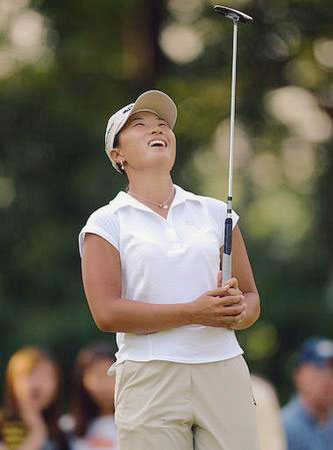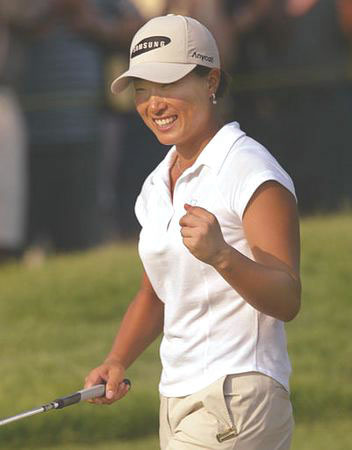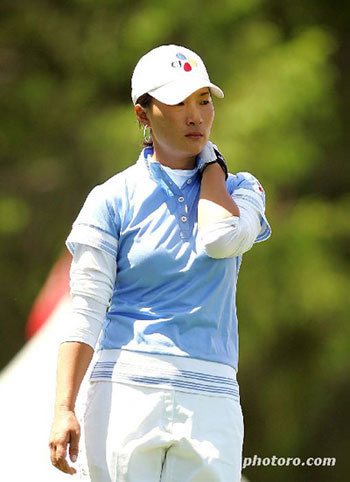 |
 |
 |
 |
 |
 |
2006 McDonald's LPGA Championship:
Long Live the Queen!
 Chapter
Two: The Young Gun
Chapter
Two: The Young Gun
Se Ri continued to play well at the LPGA Championship the next few years.
In 1999 she managed a top ten in her title defense, but could not defeat
the resurgent American player Juli Inkster. In 2000, she had a down season
where she was not able to win an event. But she came closest to collecting
a trophy that year at this very tournament, finishing third.
During these years, Pak might not have been able to collect a win in Delaware (the home of this Major at the time), but she certainly had no trouble winning elsewhere. In 1998, she would win a total of four times, and she duplicated that total in 1999. Though 2000 was a winless season, she managed a big comeback in 2001, collecting five trophies that year, including her third Major at the Weetabix British Women's Open, a new Major on tour. She had firmly established herself as the second best golfer in the world, behind only the indomitable Annika Sorenstam. And so, in 2002, she returned to Dupont Country Club, hoping to continue her success on this track.
It was a great tournament for her. While Sorenstam atypically struggled,
Se Ri hung in there for three rounds, coming up with solid stuff. But
it was bad luck for her that one player was lapping the field and seemed
destined to collect the win: Beth Daniel. The American superstar had not
won in several years, but seemed on her way to ending that streak at the
LPGA Championship. After three rounds, she sat four shots clear of Se
Ri, and nothing about the way she had played so far indicated she was
about to let the Korean star have any chance to shine.
 But
one thing Se Ri had gotten quite good at during her years in the LPGA
was making hard charges at leaders during the final round of a tournament.
In fact, she had won her third career Major at the British Open the previous
year despite being four shots out of the lead going into Sunday. Now she
found herself in the same situation again, four shots behind Daniel with
one round to go. Paired with the Hall of Famer, Se Ri was relentless in
her attack, notching two early birdies to reduce Daniel's advantage right
off the bat. On the 10th hole, Se Ri hit her approach to 18 inches, while
Daniel bogied; for the first time, Pak had the lead. But rather than let
up her assault, she continued it, increasing her lead to four shots and
winning her fourth Major easily. With this victory at the age of 24, Se
Ri became the youngest woman in history to win four Majors.
But
one thing Se Ri had gotten quite good at during her years in the LPGA
was making hard charges at leaders during the final round of a tournament.
In fact, she had won her third career Major at the British Open the previous
year despite being four shots out of the lead going into Sunday. Now she
found herself in the same situation again, four shots behind Daniel with
one round to go. Paired with the Hall of Famer, Se Ri was relentless in
her attack, notching two early birdies to reduce Daniel's advantage right
off the bat. On the 10th hole, Se Ri hit her approach to 18 inches, while
Daniel bogied; for the first time, Pak had the lead. But rather than let
up her assault, she continued it, increasing her lead to four shots and
winning her fourth Major easily. With this victory at the age of 24, Se
Ri became the youngest woman in history to win four Majors.
These were the glory days for Se Ri. Having overtaken Karrie Webb in 2001 to become the second best women's golfer in the world, she continued to extend her lead over the rest of the pack, notching five wins in 2002 and three more in 2003. But thought she had clearly become #2, she was finding it harder than ever to catch the top golfer, Annika Sorenstam. Nonetheless, Se Ri was young, she was determined, and her talent was undoubted. She was perhaps the only golfer in the world who could regularly stand up to Sorenstam, even when Annika was playing well, and come away with the win. She was getting stronger all the time, and being 7 years younger than Annika, had a lot of time yet to catch her. Things couldn't have been better for her.
Se Ri reached the apex of her career in May of 2004, when she won the
Michelob Ultra Open in Williamsburg, Virginia. That victory qualified
her, at the age of 26, for the LPGA Hall of Fame. She had accomplished
this feat so quickly that she still had three years to go before she would
have played long enough on tour to actually be inducted (there is a requirement
that a player play ten years on tour before she is allowed to join the
Hall of Fame; Se Ri was only in her seventh year).
 And
then, almost immediately, things went downhill for the Korean superstar.
And
then, almost immediately, things went downhill for the Korean superstar.
Suddenly, Pak started missing cuts, something she rarely had done to this point in her career. She had been a golfer who, especially in the previous few seasons, had finished in the top ten more often than not when she played events. Se Ri would only make one more top ten after Kingsmill for the entire rest of 2004; she wound up finishing out of the top ten on the money list that year. Some of her performances were among the worst of her career. The absolute nadir came at the Samsung World Championship, an elite field event she had won in the past. In 2004, she had such a hard time keeping her drives straight that she plunged to a last place finish, a full and shocking fifteen shots behind the second to last player in the field. How a future Hall of Famer like Se Ri Pak could have fallen to those depths in just a few short months was almost beyond explanation.
There were definitely physical issues at work. Swing changes, and perhaps
physical changes due to exercise, had greatly reduced her driving accuracy.
She suffered from the occasional injury. But the timing of her downfall
was no coincidence. It happened right after she made it into the Hall
of Fame for a reason. The pressure had been on, for years, for her to
achieve this amazing goal. It had been one of the chief aims of her entire
career. Now that it had been accomplished, she felt empty, rudderless,
not sure what her next steps should be. As she continued to struggle,
she began to question why she was putting so much work into the game.
Quite simply, she wanted a life outside of golf. She felt she had earned
it. But she had never had one; she simply didn't know what it meant to
get up in the morning and not have your first thought be about how to
improve your game. She had not taken more than a few days off from golf
since she had taken it up at the age of 14.
 As
her confusion continued, her game sank lower and lower. During the 2005
season, she battled apathy and a series of injuries. At the 2005 LPGA
Championship, the tournament where she had won two of her four Majors,
she achieved a dubious distinction: for the first time in her career,
she missed a cut at a Major. In interviews afterwards, she sounded like
someone who wanted to quit the game, someone who was getting absolutely
no joy whatsoever from playing.
As
her confusion continued, her game sank lower and lower. During the 2005
season, she battled apathy and a series of injuries. At the 2005 LPGA
Championship, the tournament where she had won two of her four Majors,
she achieved a dubious distinction: for the first time in her career,
she missed a cut at a Major. In interviews afterwards, she sounded like
someone who wanted to quit the game, someone who was getting absolutely
no joy whatsoever from playing.
Se Ri's season would come to an end during the final Major of the year,
the Women's British Open. A finger injury she sustained during the first
round forced her to not only drop out of that tournament, but to quit
for the rest of the season when she later discovered that the injury was
far worse than first thought. For the first time in her career, she was
forced away from the game, unable to practice for a period of months.
In hindsight, it might have been the best thing that ever happened to
her.